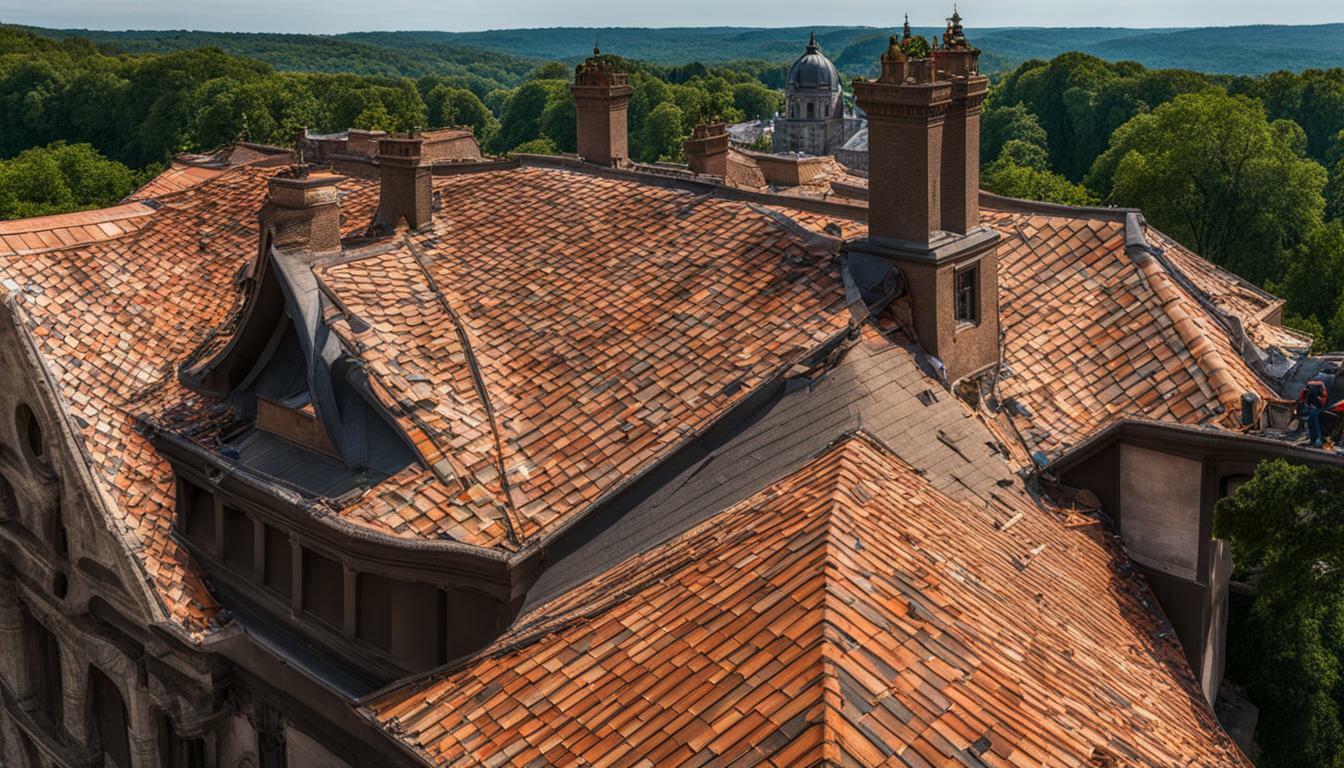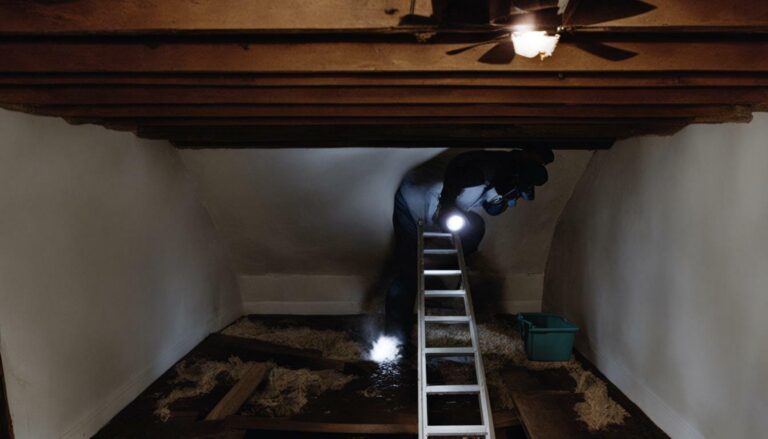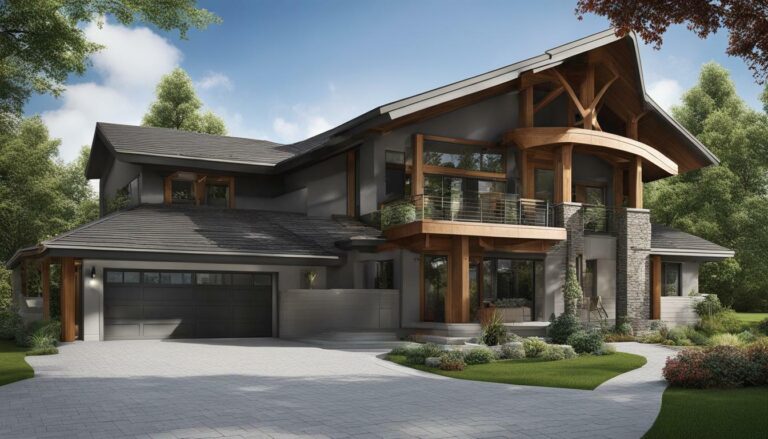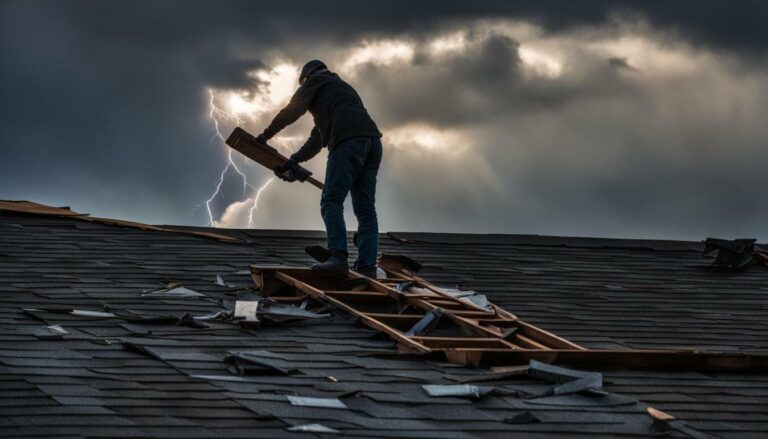Unlock the Beauty of Your Property with Historical Roof Restoration
Historical roof restoration is a crucial process that can help unlock the beauty of your property while preserving its historical value. Roofs are an important part of any structure, providing protection against the elements and enhancing curb appeal. For historic buildings, it is crucial to preserve the unique roofing structures made of durable materials. Proper maintenance and repair can prevent water damage and prolong the lifespan of the roof.
Key Takeaways:
- Preserving historical roofs is essential for maintaining the beauty and integrity of historic buildings.
- Special care and skills are required for historical roof restoration, and companies like Huber and Associates specialize in this field.
- Signs indicating the need for historical roof restoration include water stains, mold, and unusual odors inside the building.
- Historical roof restoration is recommended for buildings such as churches, courthouses, government buildings, libraries, and museums.
- The restoration process involves assessing the damage, conducting historical research, and using historically accurate tools and materials for repairs.
The Importance of Preserving Historical Roofs
Preserving historical roofs is not just about maintaining the architectural integrity of a building but also preserving a piece of history for future generations to appreciate. Historical roofs are not only beautiful but also tell a story of the past, capturing the essence of a bygone era. By restoring and preserving these roofs, we ensure that the historical significance of the building is maintained and honored.
Restoring historical roofs requires specialized knowledge and skills. These roofs are often made with unique materials and craftsmanship that may not be easily replicated today. By preserving these roofs, we safeguard the heritage of our communities and provide a tangible link to our history.
Another important reason to preserve historical roofs is their impact on property value. Historic buildings that retain their original roofs are often highly sought after by buyers and can command higher prices. A well-preserved historical roof adds to the overall aesthetic appeal of the property, creating a sense of charm and character that is hard to replicate in modern construction.
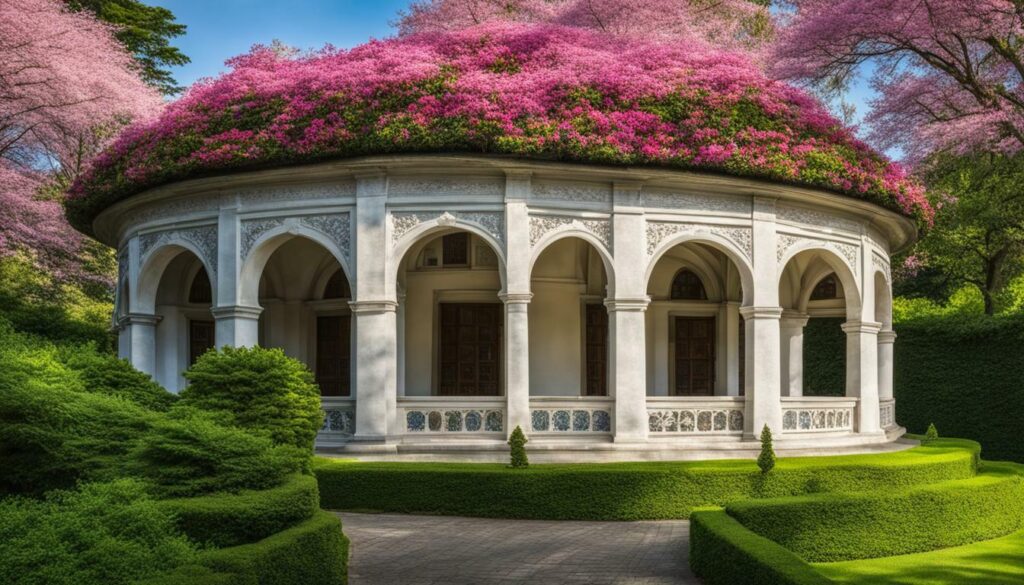
- Regular inspections: Conduct regular inspections to identify any signs of damage or deterioration.
- Maintenance practices: Implement a maintenance routine that includes cleaning the roof surface and gutters, removing debris, and addressing any minor issues promptly.
- Use of appropriate materials: When repairs are necessary, ensure that historically accurate materials are used to maintain the authenticity of the roof.
- Consult professionals: Work with experienced historical roofing contractors who specialize in restoration and preservation to ensure the best results.
By understanding the importance of preserving historical roofs and taking the necessary steps to maintain them, we can continue to appreciate the beauty and historical significance of these architectural treasures for generations to come.
Types of Historical Roofing Materials
Historical roofs can be made of various materials such as clay tile, copper, slate, and wood, each requiring unique care and maintenance. Understanding the characteristics and specific needs of these materials is crucial for preserving the beauty and longevity of historical roofs.
Clay Tile
Clay tile roofs are known for their durability and timeless appeal. These tiles are commonly seen on Mediterranean-style and Spanish Colonial homes. To ensure their longevity, clay tiles require regular maintenance, including glazing to prevent water penetration and replacing the underlayment every ten years. Cleaning the surface regularly helps prevent moss and debris buildup.
Copper
Copper roofs are a popular choice for historical buildings due to their elegance and durability. They develop a beautiful patina over time, adding character to the structure. Regular inspection is necessary to identify any wear and tear, and repairs can be done using metal patches and sealant to prevent water seepage.
Slate
Slate roofs are known for their natural beauty and longevity, often lasting over a century. However, they require regular maintenance to ensure their integrity. Preservation of slate roofs involves replacing damaged nails and applying sealant. Cleaning the surface regularly helps prevent moss and debris buildup, preserving the roof’s appearance and functionality.
Wood
Wood shingles, made of oak, cedar, and pine, offer a classic and charming look to historical buildings. However, they require careful maintenance to prevent water damage, rotting, and moss growth. Regular debris removal and the installation of zinc or copper strips are recommended. These strips help prevent water damage and inhibit the growth of moss and algae.
| Roofing Material | Main Characteristics | Maintenance Needs |
|---|---|---|
| Clay Tile | Durable, timeless, adds Mediterranean or Spanish Colonial charm | Regular glazing, underlayment replacement every ten years, cleaning to prevent moss and debris buildup |
| Copper | Elegant, durable, develops a beautiful patina over time | Regular inspection, repairs with metal patches and sealant |
| Slate | Natural beauty, longevity, can last over a century | Replacing damaged nails, applying sealant, regular cleaning to prevent moss and debris buildup |
| Wood | Classic, charming look | Regular debris removal, installation of zinc or copper strips |
Preserving historical roofs made from these materials requires special care and attention to detail. It is important to work with a reputable historical roofing company like Huber and Associates, who have expertise in working with clay tile, copper, slate, and wood. By understanding the unique maintenance needs of each material, you can ensure your historical roof remains beautiful and functional for years to come.
Unique Challenges in Historical Roof Restoration
Restoring historical roofs presents unique challenges due to their age, architectural intricacies, and the need to preserve historical elements. Historical roofs have stood the test of time, but they often require extensive repairs and restoration to maintain their beauty and functionality.
The age of historical roofs means that they have likely experienced years of wear and tear. These roofs may have been subject to weather damage, such as wind, rain, and snow, over the years. The architectural intricacies of historical roofs can make repairs more complex. These roofs often feature intricate designs, ornate details, and unique materials that may no longer be readily available.
Preserving historical elements is a critical aspect of roof restoration. It is essential to retain the historical authenticity of the roof while ensuring its structural integrity. This requires a meticulous and detailed approach to repairs, using techniques and materials that align with the original construction methods.
In addition to historical elements, many historical roofs also face the challenge of meeting modern building codes and standards. Historical buildings are often subject to preservation guidelines and regulations, which can affect the restoration process. Balancing the need for modern functionality with historical accuracy requires a skilled and knowledgeable team of experts.
Overcoming the Challenges
Despite the unique challenges, restoring historical roofs is a worthwhile endeavor. It helps preserve the architectural heritage of a building and can significantly enhance its visual appeal. By working with experienced professionals who specialize in historical roof restoration, property owners can ensure that the unique challenges are effectively addressed.
| Challenges in Historical Roof Restoration | Solutions |
|---|---|
| Age-related deterioration | Thorough assessment and restoration of damaged areas |
| Architectural intricacies | Expert knowledge and attention to detail in repairing intricate designs and ornate details |
| Limited availability of historical materials | Identifying suitable alternatives or sourcing rare materials through specialized suppliers |
| Preservation of historical elements | Adhering to preservation guidelines and using historically accurate techniques and materials |
| Meeting modern building codes | Striking a balance between historical authenticity and modern functionality |
Restoring historical roofs requires a combination of expertise, meticulous attention to detail, and a deep appreciation for preserving the historical significance of the structure. By overcoming these unique challenges, historical roof restoration can unlock the beauty of a property, ensuring its longevity for future generations to appreciate.
Choosing a Historical Roofing Company
When it comes to historical roof restoration, choosing the right roofing company is crucial for ensuring a successful and high-quality restoration project. Not all roofing companies have the expertise and experience needed to work on historical properties. Restoring historic roofs requires specialized knowledge of historical roofing materials and techniques, as well as a deep understanding of the unique challenges that come with working on these structures.
One reputable historical roofing company that stands out in the industry is Huber and Associates. With their extensive experience in historical restoration and preservation, they have earned a solid reputation for their exceptional craftsmanship and attention to detail. Their team of trained specialists is well-versed in working with a variety of materials commonly found in historical roofs, including clay tile, copper, slate, and wood.
Huber and Associates take great pride in their ability to recreate historical roofs that are not only visually stunning but also built to withstand the test of time. By utilizing modern techniques and materials, they are able to deliver restorations that are as beautiful and durable as the original. The company has worked on numerous historically designated properties, including prestigious landmarks such as the Biltmore Estate and the South Carolina Historical Society building.
The Expertise of Huber and Associates
Huber and Associates have received recognition for their outstanding work in the field of historical roof restoration. They have been honored with awards such as the Griffin Award and the Gold Circle Award, which further demonstrate their commitment to excellence. From conducting thorough assessments to implementing historically accurate repairs, their team of specialists ensures that every restoration project meets the highest standards of quality and authenticity.
When choosing a historical roofing company, it is important to consider their track record, expertise, and reputation. Huber and Associates not only possess extensive knowledge and experience in historical roof restoration but also prioritize customer satisfaction. They work closely with property owners to understand their specific needs and goals, ensuring a smooth and successful restoration process.
| Benefits of Choosing Huber and Associates |
|---|
| Expertise in working with historical roofing materials |
| Attention to detail and craftsmanship |
| Experience working on historically designated properties |
| Awards and recognition for their outstanding work |
| Commitment to customer satisfaction |
Restoring historic roofs is a delicate and intricate process that requires the skill and expertise of a specialized roofing company. By choosing a reputable company like Huber and Associates, property owners can unlock the true beauty of their historical properties and ensure that their roofs are preserved for future generations to appreciate.
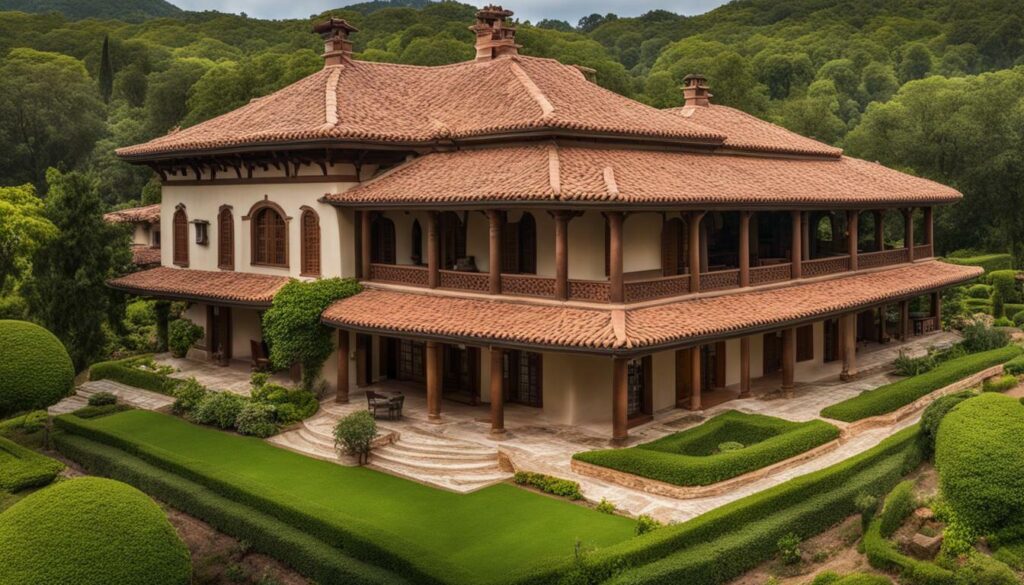
It is important to be aware of the signs that indicate your historical roof may be in need of restoration or replacement to prevent further damage and preserve its integrity. Ignoring these signs can lead to costly repairs or even structural instability. Here are some key indicators that it’s time to consider restoring your historical roof:
- Water stains: Persistent water stains on your ceiling or walls are a clear sign of a compromised roof. Leaks can damage the structural components of your building and foster the growth of mold and mildew.
- Missing or damaged shingles: If you notice missing, cracked, or curling shingles, it’s a sign that your roof is no longer effectively protecting your property. Damaged shingles can allow water to seep into your building and cause extensive damage.
- Sagging or uneven roof: A visibly sagging or uneven roofline indicates underlying structural issues that require immediate attention. This could be a result of rotting wood, weakened foundation, or inadequate support.
- Higher energy bills: An aging and inefficient roof can lead to increased energy consumption as it fails to insulate your property properly. If you notice a steady rise in your energy bills, it may be time to consider restoring your historical roof.
When you observe any of these signs, it is crucial to consult with a reputable historical roofing company like Huber and Associates. Their experienced team can assess the condition of your roof and provide professional recommendations tailored to your specific needs.
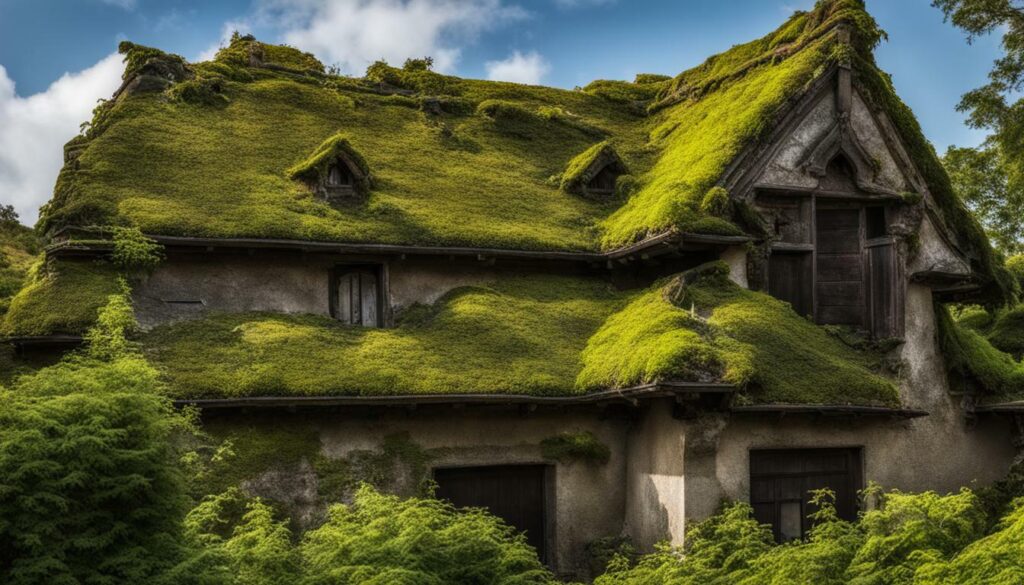
“We take pride in our expertise and commitment to preserving the historical significance of your property through our meticulous restoration work.” – Huber and Associates
Huber and Associates is a trusted historical roofing contractor known for their exceptional craftsmanship and attention to detail. With years of experience in restoring roofs of various historical buildings, including churches, courthouses, and museums, they understand the unique challenges and requirements of preserving the architectural integrity of historical properties.
Their team of trained specialists uses modern techniques and historically accurate tools and materials to ensure that the restored roof is as beautiful and durable as the original. They have received industry recognition for their work, including the prestigious Griffin Award and the Gold Circle Award.
When it comes to historical roof restoration, trust Huber and Associates to deliver results that exceed your expectations. Contact them today for a consultation and let their expertise unlock the renewed beauty of your historical property.
The Restoration Process for Historical Roofs
The restoration process for historical roofs requires meticulous planning, careful assessment, and the use of historically accurate restoration techniques and materials. It is a delicate and specialized task that requires the expertise of professionals who understand the unique challenges of working with historical structures.
First, a thorough assessment of the roof’s condition is conducted. This involves inspecting the entire roofing system, identifying any damage or deterioration, and determining the scope of the restoration work. The assessment may include the examination of historical documents and photographs to ensure that the restoration is faithful to the original design.
Next, a detailed plan is developed, outlining the specific restoration steps and the materials to be used. This plan takes into account the historical significance of the building and aims to preserve its original character. It may involve sourcing materials that closely match the original ones or replicating them using traditional methods.
Once the planning is complete, the restoration work begins. This typically includes repairing or replacing damaged roofing materials, reinforcing the structural integrity of the roof, and applying protective coatings to resist future damage. Throughout the process, attention to detail is crucial, as every element must be restored with precision to maintain the historical integrity of the building.
| Key Steps in the Restoration Process | Description |
|---|---|
| Assessment | A thorough examination of the roof’s condition, including historical research. |
| Planning | Development of a detailed plan outlining restoration steps and materials to be used. |
| Repair and Replacement | Repairing or replacing damaged roofing materials and reinforcing structural integrity. |
| Preservation | Applying protective coatings to resist future damage and ensure longevity. |
The restoration process for historical roofs is a labor-intensive endeavor that requires a deep understanding of the building’s history and architectural design. It is a meticulous process that aims to protect the building’s legacy and contribute to its overall beauty and longevity.
By following this careful restoration process, historical roofs can be brought back to their former glory, ensuring that these cherished architectural treasures are preserved for future generations to admire and appreciate. The restoration work not only enhances the aesthetic appeal of the property but also contributes to the overall cultural and historical preservation of our built heritage.
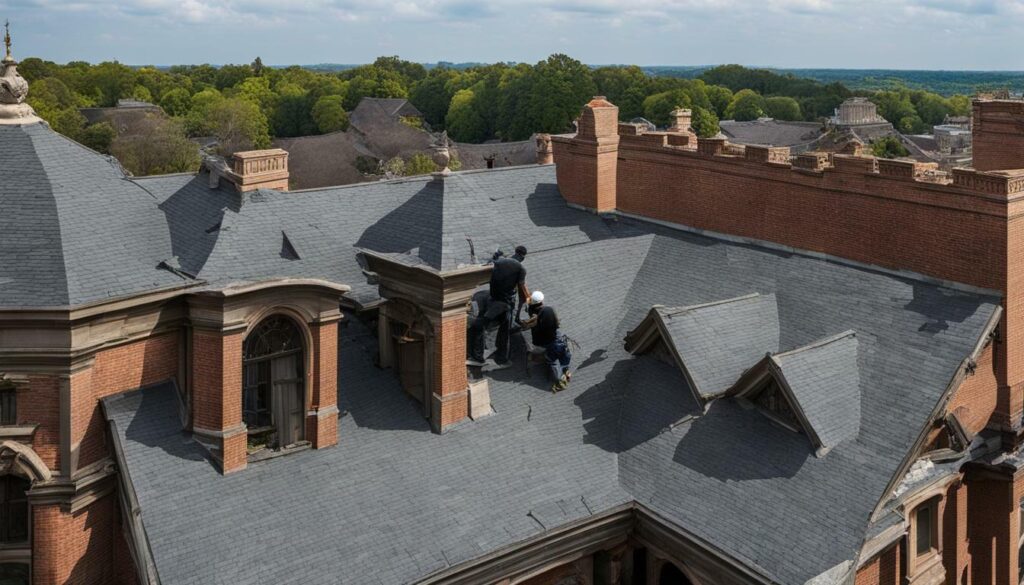
Restoring historical roofs requires the expertise and craftsmanship of experienced professionals who are well-versed in the specific needs of historical structures. Companies like Huber and Associates specialize in historical roof restoration, utilizing their knowledge of materials, techniques, and historical accuracy to deliver exceptional results.
Huber and Associates – Your Trusted Historical Roofing Contractor
Huber and Associates is a reputable historical roofing company with a team of trained specialists dedicated to preserving the beauty and integrity of historical roofs. With their expertise in historical restoration and preservation, they have successfully worked on numerous projects, including prestigious properties like the Biltmore Estate and the South Carolina Historical Society building.
As a trusted historical roofing contractor, Huber and Associates understand the importance of using the right materials and techniques to ensure that the restored roofs are as beautiful and durable as the original. They specialize in working with a variety of roofing materials, including clay tile, copper, slate, and wood. By combining modern technologies with traditional craftsmanship, they are able to create restorations that are both historically accurate and long-lasting.
When it comes to historical roof restoration, Huber and Associates are known for their commitment to quality and integrity. Their team of specialists undergoes rigorous training to stay updated with the latest industry standards and techniques. They have received prestigious awards, such as the Griffin Award and the Gold Circle Award, which further highlight their expertise and reputation in the field of historical roof restoration.
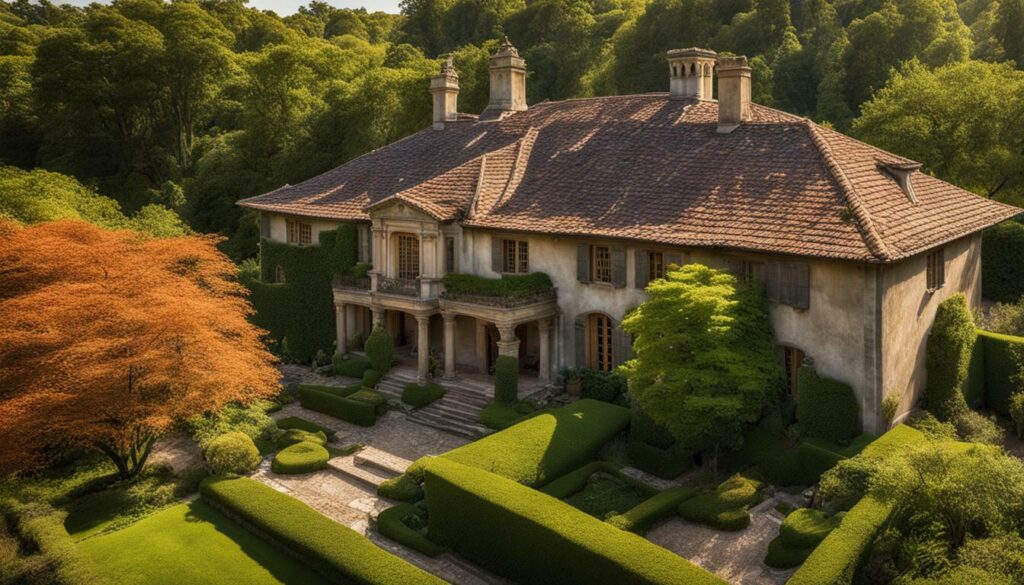
| Benefits of Huber and Associates: | Notable Projects: |
|---|---|
|
|
Notable Historical Roof Restoration Projects
Huber and Associates have successfully completed numerous historical roof restoration projects, with notable examples including the iconic Biltmore Estate and the historic South Carolina Historical Society building. These prestigious properties showcase the expertise and commitment to quality that Huber and Associates brings to each restoration project.
The Biltmore Estate, located in Asheville, North Carolina, is a breathtaking example of historical architecture. Its roof, made of clay tiles, required extensive restoration to preserve its original beauty. Huber and Associates meticulously repaired and replaced damaged tiles, ensuring that the roof maintained its historical accuracy while providing lasting protection.
The South Carolina Historical Society building, situated in Charleston, South Carolina, is another remarkable project undertaken by Huber and Associates. The building’s roof, made of ornamental metal, required intricate restoration work to preserve its intricate design and historical significance. With their expertise in working with ornamental metal, Huber and Associates successfully restored the roof to its former grandeur.
These projects demonstrate not only the technical expertise of Huber and Associates but also their dedication to preserving the historical integrity of each property. Through their meticulous restoration work, they ensure that these architectural treasures continue to inspire and amaze for generations to come.
Table: Historical Roof Restoration Projects
| Property | Location | Roofing Material |
|---|---|---|
| Biltmore Estate | Asheville, North Carolina | Clay Tiles |
| South Carolina Historical Society building | Charleston, South Carolina | Ornamental Metal |
| [Property] | [Location] | [Roofing Material] |
| [Property] | [Location] | [Roofing Material] |
Image: 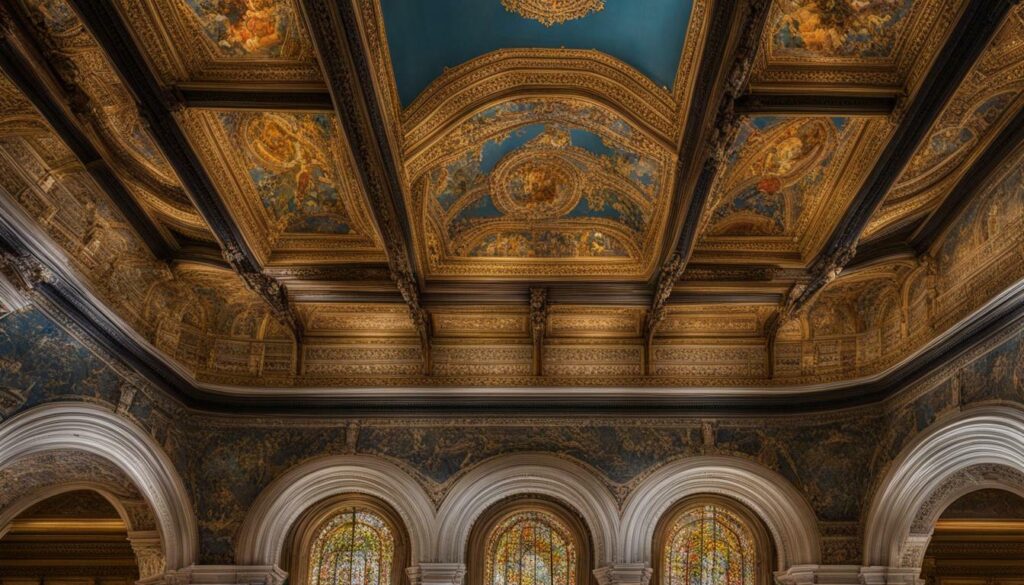
The image above showcases the meticulous craftsmanship and attention to detail that Huber and Associates brings to every historical roof restoration project. With their expertise and passion for preserving historical architecture, they continue to unlock the beauty of properties like the Biltmore Estate and the South Carolina Historical Society building.
By choosing Huber and Associates for your historical roof restoration needs, you can trust that your property will receive the highest level of care and expertise. Their extensive portfolio of successful projects, including these notable examples, is a testament to their commitment to excellence in historical roof restoration.
Once your historical roof has been restored, proper maintenance is key to ensuring its long-lasting beauty and resilience. By implementing a regular maintenance routine, you can protect your investment and preserve the historical significance of your property. Here are some essential steps to take:
- Inspect the roof regularly: Conduct visual inspections at least twice a year, in the spring and fall, to identify any signs of damage or wear. Look for loose tiles, missing shingles, cracks, or signs of water damage.
- Clean the roof: Remove debris such as leaves, branches, and moss that can accumulate on the roof surface. Use a soft-bristle brush or a leaf blower to gently remove dirt and organic materials.
- Address repairs promptly: If you notice any issues during your inspections, it is vital to address them promptly. Ignoring small problems can lead to more significant damage and costly repairs down the line.
- Trim trees and vegetation: Overhanging branches can cause physical damage to the roof and provide a pathway for rodents and pests. Trim any branches or vegetation that are in close proximity to the roof.
- Keep gutters and downspouts clean: Proper drainage is essential for the health of your roof. Clear out any debris from gutters and downspouts to prevent water backup and potential water damage.
- Protect against UV rays: Exposure to the sun’s UV rays can cause fading and deterioration of roofing materials. Consider applying a protective coating or using UV-resistant shingles to extend the lifespan of your roof.
By following these maintenance practices, you can ensure that your historical roof remains in optimal condition and retains its original charm for years to come. Remember, if you are unsure about any aspect of roof maintenance or need assistance, it is always best to consult with a professional roofing contractor.
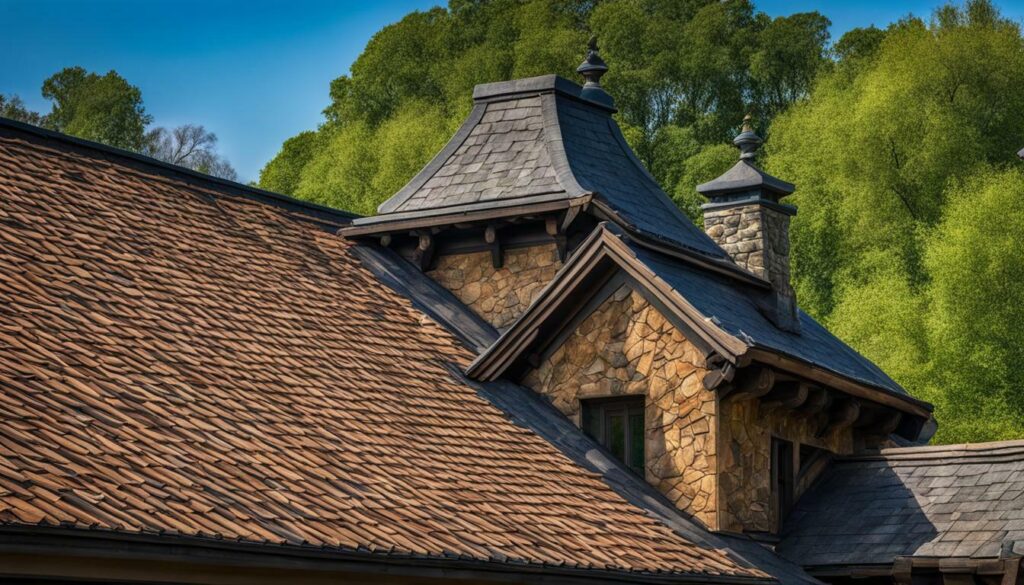
“I am extremely satisfied with the historical roof restoration work done by Huber and Associates. They not only restored the beauty of my property but also ensured that the historical integrity was preserved. Their attention to detail and professionalism throughout the process was truly commendable. I highly recommend their services to anyone in need of historical roof restoration.”
| Benefits of Historical Roof Maintenance |
|---|
| Preserves the historical character of the property |
| Enhances the curb appeal and aesthetics |
| Protects against water damage and leaks |
| Increases the property’s value and marketability |
| Ensures the longevity and structural integrity of the roof |
Benefits of Historical Roof Restoration
Historical roof restoration offers a range of benefits, from preserving the historical value of a property to improving its overall aesthetics and potentially increasing its value. Restoration projects aim to bring back the original beauty and charm of historical roofs, which can greatly enhance the visual appeal of a building.
One of the most significant benefits of historical roof restoration is the preservation of a property’s historical value. Historical buildings are important cultural and architectural landmarks, and their roofs are often key features that reflect the era in which they were constructed. By restoring these roofs to their former glory, property owners can contribute to the preservation of history and maintain the architectural integrity of the structure.
Furthermore, a restored roof can greatly improve the overall aesthetics of a property. Historical roofs often boast intricate designs and unique materials that are no longer commonly used in modern construction. By restoring these elements, property owners can create a visually stunning and distinctive look that adds character and charm to their building.
In addition to preserving history and enhancing aesthetics, historical roof restoration can potentially increase the value of a property. Properties with well-maintained historical roofs are highly sought after by buyers who value the uniqueness and craftsmanship of these structures. A restored historical roof can significantly boost the market value of a property, making it a wise investment for property owners.
Table: Benefits of Historical Roof Restoration
| Benefits | Description |
|---|---|
| Preservation of history | Restoring historical roofs helps maintain the architectural integrity of the building and contributes to preserving cultural heritage. |
| Enhanced aesthetics | Restored historical roofs add character and charm to a property, creating a visually appealing and unique look. |
| Increased property value | Properties with well-maintained historical roofs can command higher prices in the real estate market due to their uniqueness and craftsmanship. |
Overall, historical roof restoration offers a wide range of benefits for property owners. By investing in the preservation and restoration of historical roofs, property owners can unlock the beauty of their properties, maintain cultural heritage, and potentially increase their property’s value.
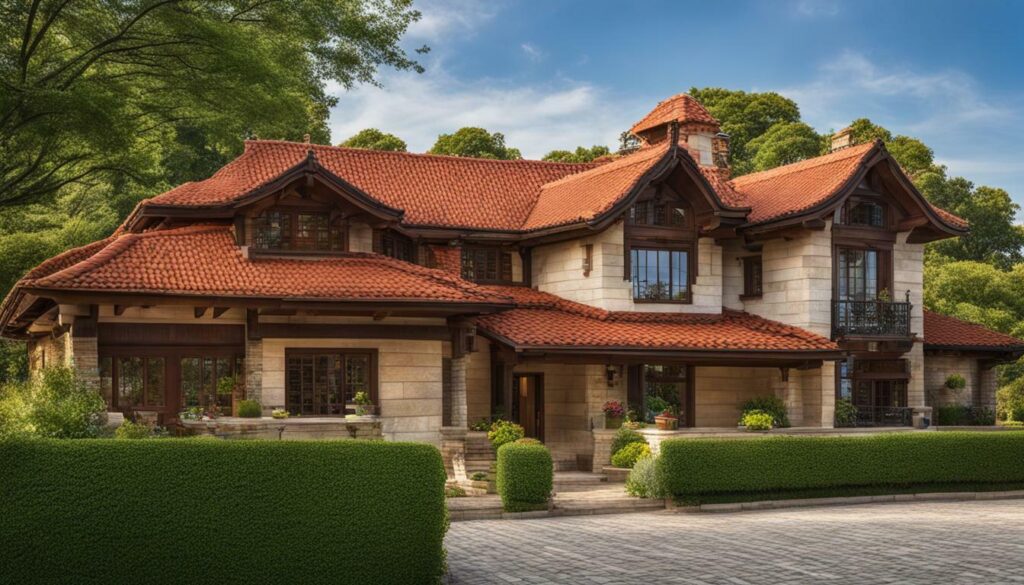
Historical roof restoration is not just about repairing and preserving roofs; it is a vital process that helps unlock the beauty of historic properties and ensure their longevity for generations to come.
Roofs are an important part of any structure, providing protection against the elements and enhancing curb appeal. For historic buildings, it is crucial to preserve the unique roofing structures made of durable materials. Proper maintenance and repair can prevent water damage and prolong the lifespan of the roof.
Wood shingles, made of oak, cedar, and pine, require regular debris removal and the installation of zinc or copper strips to prevent water damage, rotting, and moss growth. Metal roofs, such as copper rolls, aluminum sheets, and tin shingles, need frequent inspection to identify wear and tear. Repairs can be done with metal patches and sealant to prevent water seepage. Slate roofs should be preserved by replacing damaged nails and applying sealant. Cleaning the surface regularly helps prevent moss and debris buildup. Clay tiles should have the underlayment replaced every ten years and the tiles glazed regularly to prevent water penetration.
Preserving historical roofs requires special care and skills. Companies like Huber and Associates specialize in historical restoration and preservation, with expertise in working with materials like clay tile, copper, slate, and wood. Their goal is to create restorations that are as beautiful and durable as the original, using modern techniques and materials. They have worked on numerous historically designated properties, including the Biltmore Estate and the South Carolina Historical Society building.
To determine when a roof should be restored, factors such as the material, age, installation quality, and maintenance should be considered. Signs of potential roof problems include water stains, mold, and unusual odors inside the building. It is recommended to have the roof examined by professionals who can provide assessments and recommendations for repair or replacement.
Historic buildings that should have their roofs restored include churches, courthouses, government buildings, historical sites, libraries, lodges, museums, national park buildings, plantations, and university buildings. Huber and Associates is a reputable roofing contractor for historical roof restoration, with a team of trained specialists who are committed to quality and integrity. They have received awards for their work, including the Griffin Award and the Gold Circle Award.
The restoration process for historical roofs involves assessing the damage, conducting historical research, and performing repairs using historically accurate tools and materials when necessary. Huber and Associates have expertise in working with roofing materials like copper, ornamental metal, slate, clay tiles, and wood.
In conclusion, historical roof restoration is important for preserving the beauty and integrity of historic buildings. Proper maintenance and repair can protect against water damage and extend the lifespan of the roof, enhancing the overall appeal of the property.
FAQ
Q: Why is historical roof restoration important?
A: Historical roof restoration is important for preserving the beauty and integrity of historic buildings. It helps protect against water damage and extends the lifespan of the roof, enhancing the overall appeal of the property.
Q: What types of historical roofing materials are there?
A: Historical roofing materials include clay tile, copper, slate, and wood. Each material has specific maintenance requirements to ensure their longevity.
Q: How can I determine if my historical roof needs restoration?
A: Signs that your historical roof needs restoration include water stains, mold, and structural damage. It is recommended to have the roof examined by professionals who can provide assessments and recommendations for repair or replacement.
Q: What is the process involved in historical roof restoration?
A: The restoration process for historical roofs involves assessing the damage, conducting historical research, and performing repairs using historically accurate tools and materials when necessary.
Q: How do I choose a historical roofing company?
A: When choosing a historical roofing company, look for a reputable contractor with expertise in restoration and preservation. Consider their track record, experience with historical materials, and reputation in the industry.
Q: What are the benefits of historical roof restoration?
A: The benefits of historical roof restoration include increased property value, preservation of history, and enhanced aesthetics. It can also prevent further damage and ensure the longevity of the roof.
Q: Can you give an example of a notable historical roof restoration project?
A: Huber and Associates have worked on prestigious projects such as the restoration of the Biltmore Estate and the South Carolina Historical Society building, showcasing their expertise in historical roof restoration.
Q: How can I maintain the beauty of my restored historical roof?
A: To maintain the beauty of your restored historical roof, it is important to conduct regular inspections and perform necessary maintenance practices, such as cleaning and repairing any damage promptly.
Q: Why should I choose Huber and Associates for historical roof restoration?
A: Huber and Associates are a trusted historical roofing contractor with a reputation for exceptional restoration work. They have expertise in working with various historical roofing materials and have received awards for their craftsmanship.
Q: What are the benefits of preserving historical roofs?
A: Preserving historical roofs helps maintain the architectural integrity of historic buildings, contributes to the preservation of history, and enhances the overall visual appeal of the property.
